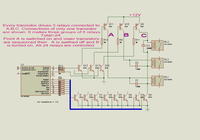Sajjadkhan
Full Member level 5
- Joined
- Sep 25, 2010
- Messages
- 307
- Helped
- 17
- Reputation
- 34
- Reaction score
- 16
- Trophy points
- 1,298
- Location
- Rawalpindi,Pakistan
- Activity points
- 4,199
I need to make 24 fans controller. the board has a lcd display and few buttons for settings.
the main issue here is controller I/O pins and cost.
24 pins for fans (220v)
6 pins for lcd,
3 pins for buttons i.e. adjust, up, down ( for setting ON/OFF timer ).
i dont want to use 40 pin controller, 28 pin or less would be fine, then i would also be needing some port expansion method.
so throw me some ideas for a cheapest design possible to workout this problem, i need to make 500 boards with max profit margin.
the main issue here is controller I/O pins and cost.
24 pins for fans (220v)
6 pins for lcd,
3 pins for buttons i.e. adjust, up, down ( for setting ON/OFF timer ).
i dont want to use 40 pin controller, 28 pin or less would be fine, then i would also be needing some port expansion method.
so throw me some ideas for a cheapest design possible to workout this problem, i need to make 500 boards with max profit margin.
